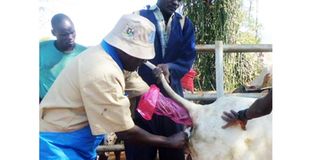Managing livestock pests and diseases through community health workers

Dr Ilukol (L) demonstrates how to prepare a cow for artificial insemination. Photo BY LOMINDA AFEDRARU
Since rearing livestock is the main farming activity in Karamoja, the farmers would like to keep their animals safe from pest and diseases. And it is the reason why they consider the services of Community Animal Health Workers (CAHWs) to be very important.
Being nomadic pastoralists, they would not settle in one place as they kept moving in search of the best pastures. But this trend is beginning to change due to frequent pests infestation and disease outbreaks, which require veterinary attention.
Since there are few veterinary professionals in the region, a total of more than 600 CAHWs have been trained to conduct surveillance, immunise and treat animals. Over the years, in each community, these health workers have formed associations to mobilise funds for purchasing drugs while others have set up clinics, which they manage as a group, to provide animal health services.
Vet groups
In 2012, with support from Spain, Food and Agricultural Organisation they implemented a training of CAHWs in livestock healthcare and production. Each one was then given start kit that comprised drugs, needles, syringes, protective gear, a bag and a bicycle. Dr Mark Poi Ilukol, a veterinary doctor, says community health workers are key in identifying different animal diseases that keep emerging as a result of climate change.
The livestock in the region mostly suffer from Anaplasmosis (which results into fever and pneumonia), East Coast Fever, abdominal bloating, foot and mouth disease, brucellosis, trypanosomiasis, and Peste des petits ruminants.
Peste des petits disease, which was first reported in parts of the northern and eastern regions in 2006 is now a common disease in Karamoja. It mostly affects sheep and goats but the symptoms are similar to those of rinderpest in cattle. But with the help of CAHWs, the frequency of outbreaks is reducing.
Services
Andrew Ayopo, a CAHW, from Lopiri village in Moroto District says since farmers in the communities want to see their livestock healthy, they usually approach his team willingly in case of any infection. The charges for treatment range from Shs500 to Shs2,000 depending on the gravity of the illness. Spraying animals to eliminate ticks is cheaper than use of drugs. However, Ayopo says, the types of diseases are many and it remains a challenge to eliminate all of them.
Usually farmers approach these health workers to purchase drugs but some call them to treat the animals from their homes. Apart from providing treatment, occasionally they provide vaccination against some of the viral diseases such as Contagious Caprine Pleuropneumonia and Peste des Petits Ruminants.
Results
The surveillance of diseases CAHWs has enhanced timely reporting and response. As a result, the outbreaks have been contained to a greater extent. During prolonged dry seasons or droughts, farmers have learnt to process dry hay which they preserve and serve to animals when they run out of pasture. Traditionally, Karimojong livestock keepers migrate during dry seasons in search of grazing pasture but some farmers now harvest grass to make hay. They store it and provide to the animals in dry season although they ration among goats, sheep and milking cows.
Better breeds
Since most farmers in Karamoja do not tend to sell cattle. Many farmers have resorted to rearing goats which, according to Dr Mark Poi Ilukol, can be preserved for quick income earnings. The prices range from Shs100,000 to Shs200,000 depending on the size and quality. Under the FAO project, superior male goats have been given to farmers’ groups to improve the breeds. Artificial insemination of local cattle breeds is also in the pipeline.
The veterinary team is in the process of acquiring semen of high breed cattle such as Sahiwal, which will be crossed with the local breeds for improved weight and higher milk yields. It is a type of Zebu cattle which is known for high milk production and originated from the Sahiwal district of Pakistan, hence the name




